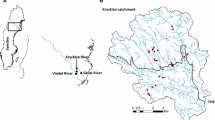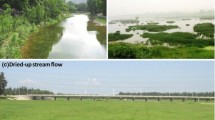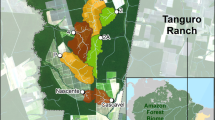Abstract
Ephemeral reaches are common along desert rivers but are less well studied than those with perennial stream flow. This study contrasted riparian plant species richness and composition (extant vegetation and soil seed bank) between stream reaches with different low-flow conditions (perennial vs. ephemeral flow) but similar flood patterns and similar watershed-derived species pools. Data were collected at Cienega Creek (Arizona, USA) over a 2 year period spanning drought conditions and wetter conditions. Consistent with expectations relating to water limitation effects on diversity, species richness in the riparian zone was lower at ephemeral-flow sites during a season with minimal precipitation and no overbank flooding; under these conditions, the more permanent water sources of the perennial-flow sites sustain the larger number of species. During seasons with greater precipitation and elevated stream flows, in contrast, species richness at ephemeral-flow sites increased to levels at or slightly above those of perennial-flow sites. For values pooled across two wet seasons of a calendar year, year-round richness was greater at the two ephemeral-flow sites (total of 92 vascular plant species) than at the two perennial-flow sites (68 species). This greater year-round richness was a combination of multiple factors: greater light, space, and bare ground, a diverse soil seed bank (with the seed banks equally species-rich among hydrologic types), and moderately abundant precipitation and flooding sufficient to stimulate establishment of opportunistic species (mainly annuals) during the bimodal wet seasons. These results indicate that long-term patterns of site water availability, by influencing woody plant cover, mediate the diversity response to episodic water pulses in dryland rivers. The results also have implications for riparian conservation efforts, which to date have focused primarily on perennial stream reaches: ephemeral reaches of spatially intermittent rivers harbor many riparian plant species, and warrant conservation efforts, as well.



Similar content being viewed by others
References
Ali MM, Dickinson G, Murphy KJ (2000) Predictors of plant diversity in a hyperarid desert wadi ecosystem. J Arid Environ 45:215–230. doi:10.1006/jare.2000.0631
Auble GT, Friedman JM, Scott ML (1994) Relating riparian vegetation to present and future streamflows. Ecol Appl 4:544–554. doi:10.2307/1941956
Bagstad KJ, Stromberg JC, Lite SJ (2005) Response of herbaceous riparian plants to rain and flooding on the San Pedro River, Arizona, USA. Wetlands 25:210–223. doi:10.1672/0277-5212(2005)025[0210:ROHRPT]2.0.CO;2
Birkeland GH (1996) Riparian vegetation and sandbar morphology along the lower Little Colorado River, Arizona. Phys Geogr 17:534–553
Bloss DA, Brotherson JD (1979) Vegetation response to a moisture gradient on an ephemeral stream in central Arizona. Gt Basin Nat 39:161–176
Boudell JA, Stromberg JC (2008a) Propagule banks: potential contribution to restoration of an impounded and dewatered riparian ecosystem. Wetlands 28:656–665
Boudell JA, Stromberg JC (2008b) Flood pulsing and metacommunity dynamics in desert riparian ecosystems. J Veg Sci 19:373–380
Brock MA, Rogers KH (1998) The regeneration potential of the seed bank of an ephemeral floodplain in South Africa. Aquat Bot 61:123–135. doi:10.1016/S0304-3770(98)00062-X
Brown D (1992) Estimating the composition of a forest seed bank—a comparison of the seed extraction and seedling emergence methods. Can J Bot 70:1603–1612
Bunn SE, Thoms MC, Hamilton SK, Capon SJ (2006) Flow variability in dryland rivers: boom, bust and the bits in between. River Res Appl 22:179–186. doi:10.1002/rra.904
Busch DE, Smith SD (1995) Mechanisms associated with decline of woody species in riparian ecosystems of the southwestern US. Ecol Monogr 65:347–370. doi:10.2307/2937064
Capon SJ (2007) Effects of flooding on seedling emergence from the soil seed bank of a large desert floodplain. Wetlands 27:904–914. doi:10.1672/0277-5212(2007)27[904:EOFOSE]2.0.CO;2
Capon SJ, Brock MA (2006) Flooding, soil seed bank dynamics and vegetation resilience of a hydrologically variable desert floodplain. Freshw Biol 51:206–223. doi:10.1111/j.1365-2427.2005.01484.x
Colwell RK (2005) EstimateS, Ver. 7.5: statistical estimation of species richness and shared species from samples (statistical estimation software with 20 p manual)
Goodson JM, Gurnell AM, Angold PG, Morrissey IP (2003) Evidence for hydrochory and the deposition of viable seeds within winter flow-deposited sediments: the River Dove, Derbyshire. UK River Res Appl 19:317–334. doi:10.1002/rra.707
Grime JP (1973) Competitive exclusion in herbaceous vegetation. Nature 242:344–347. doi:10.1038/242344a0
Gutierrez JR, Meserve PL (2003) El Nino effects on soil seed bank dynamics in north-central Chile. Oecologia 134:511–517
Hancock CN, Ladd PG, Froend RH (1996) Biodiversity and management of riparian vegetation in Western Australia. For Ecol Manag 85:239–250. doi:10.1016/S0378-1127(96)03761-9
Horton JL, Kolb TE, Hart SH (2001) Physiological response to groundwater depth varies among species and with river flow regulation. Ecol Appl 11:1046–1059. doi:10.1890/1051-0761(2001)011[1046:PRTGDV]2.0.CO;2
Jansson R, Zinko U, Merritt DM, Nilsson C (2005) Hydrochory increases riparian plant species richness: a comparison between a free-flowing and a regulated river. J Ecol 93:1094–1103. doi:10.1111/j.1365-2745.2005.01057.x
Jansson R, Laudon H, Johansson E, Augspurger C (2007) The importance of groundwater discharge for plant species number in riparian zones. Ecology 88:131–139. doi:10.1890/0012-9658(2007)88[131:TIOGDF]2.0.CO;2
Johansson ME, Nilsson C, Nilsson E (1996) Do rivers function as corridors for plant dispersal? J Veg Sci 7:593–598. doi:10.2307/3236309
Kearney TH, Peebles RH (1960) Arizona flora (with supplement). University of California Press, Berkeley
Killingbeck KT, Whitford WG (2001) Nutrient resorption in shrubs growing by design, and by default in Chihuahuan Desert arroyos. Oecologia 128:351–359. doi:10.1007/s004420100668
Kolb TE, Hart SC, Amundson R (1997) Boxelder water sources and physiology at perennial and ephemeral stream sites in Arizona. Tree Physiol 17:151–160
Leitner LA (1987) Plant communities of a large arroyo at Punta Cirio, Sonora. Southwest Nat 32:21–28. doi:10.2307/3672005
Lite SJ, Bagstad KJ, Stromberg JC (2005) Riparian plant species richness along lateral and longitudinal gradients of water stress and flood disturbance, San Pedro River, Arizona, USA. J Arid Environ 63:785–813. doi:10.1016/j.jaridenv.2005.03.026
Liu GH, Li W, Li EH, Yuan LY, Davy AJ (2006) Landscape-scale variation in the seed banks of floodplain wetlands with contrasting hydrology in China. Freshw Biol 51:1862–1878. doi:10.1111/j.1365-2427.2006.01621.x
Meinzer OE (1923) Outline of ground-water hydrology, with definitions. US Geol Surv Water Supply Pap 494:1–71
Mouw JEB, Alaback PB (2003) Putting floodplain hyperdiversity in a regional context: an assessment of terrestrial-floodplain connectivity in a montane environment. J Biogeogr 30:87–103. doi:10.1046/j.1365-2699.2003.00775.x
Naiman RJ, De Camps H, Pollock M (1993) The role of riparian corridors in maintaining regional biodiversity. Ecol Appl 3:209–212. doi:10.2307/1941822
Nanson GC, Tooth S, Knighton AD (2002) A global perspective on dryland rivers: perceptions, misconceptions and distinctions. In: Bull LJ, Kirkby MJ (eds) Dryland rivers: hydrology and geomorphology of semi-arid channels. Wiley, Chichester, pp 17–54
Nicol JM, Ganf GG, Pelton GA (2003) Seed banks of a southern Australian wetland: the influence of water regime on the final floristic composition. Plant Ecol 168:191–205. doi:10.1023/A:1024430919811
Poff NL, Allan JD, Bain MB, Karr JR, Prestegaard KL, Richter BD, Stromberg JC (1997) The natural flow regime: a paradigm for river conservation and restoration. Bioscience 47:769–784. doi:10.2307/1313099
Pollock MM, Naiman RJ, Hanley TA (1998) Plant species richness in riparian wetlands—a test of biodiversity theory. Ecology 79:94–105
Robertson HA, James KR (2007) Plant establishment from the seed bank of a degraded floodplain wetland: a comparison of two alternative management scenarios. Plant Ecol 188:145–164. doi:10.1007/s11258-006-9153-0
Rundel PW, Sturmer SB (1998) Native plant diversity in riparian communities of the Santa Monica Mountains, California. Madrono 45:93–100
Sabo JL, Sponseller R, Dixon M, Gade K, Harms T, Heffernan J, Jani A, Katz G, Soykan C, Watts J, Welter A (2005) Riparian zones increase regional species richness by harboring different, not more, species. Ecology 86:56–62. doi:10.1890/04-0668
Salinas MJ, Casas JJ (2007) Riparian vegetation of two semi-arid Mediterranean rivers: basin-scale responses of woody and herbaceous plants to environmental gradients. Wetlands 27:831–845. doi:10.1672/0277-5212(2007)27[831:RVOTSM]2.0.CO;2
Sambatti JBM, Rice KJ (2006) Local adaptation, patterns of selection, and gene flow in the Californian serpentine sunflower (Helianthus exilis). Evol Int J Org Evol 60:696–710
Sarr DA (2002) Riparian livestock exclosure research in the western United States: a critique and some recommendations. Environ Manag 30:516–526. doi:10.1007/s00267-002-2608-8
Schade JD, Sponseller R, Collins SL, Stiles A (2003) The influence of Prosopis canopies on understorey vegetation: effects of landscape position. J Veg Sci 14:743–750. doi:10.1658/1100-9233(2003)014[0743:TIOPCO]2.0.CO;2
Shaw JR, Cooper DJ (2008) Linkages among watersheds, stream reaches, and riparian vegetation in dryland ephemeral stream networks. J Hydrol (Amst) 350:68–82. doi:10.1016/j.jhydrol.2007.11.030
Sponseller RA, Fisher SG (2006) Drainage size, stream intermittency, and ecosystem function in a Sonoran Desert landscape. Ecosystems (N Y, Print) 9:344–356. doi:10.1007/s10021-005-0167-6
Stromberg JC (2007) Seasonal reversals of upland-riparian diversity gradients in the Sonoran Desert. Divers Distrib 13:70–83
Stromberg JC, Bagstad KJ, Leenhouts JM, Lite SJ, Makings E (2005) Effects of stream flow intermittency on riparian vegetation of a semiarid region river (San Pedro River, Arizona). River Res Appl 21:925–938. doi:10.1002/rra.858
Stromberg JC, Beauchamp VB, Dixon MD, Lite SJ, Paradzick C (2007) Importance of low-flow and high-flow characteristics to restoration of riparian vegetation along rivers in arid southwestern United States. Freshw Biol 52:651–679. doi:10.1111/j.1365-2427.2006.01713.x
Stromberg JC, Boudell JA, Hazelton AF (2008) Differences in seed mass between hydric and xeric plants influence seed bank dynamics in a dryland riparian ecosystem. Funct Ecol 22:205–212. doi:10.1111/j.1365-2435.2007.01375.x
Stromberg JC, Hazelton AF, White MS, White JM, Fischer RA Ephemeral wetlands along a spatially intermittent river: temporal patterns of vegetation development. Wetlands (in press)
Tabacchi E, Planty-Tabacchi A, Salinas MJ, Décamps H (1996) Landscape structure and diversity in riparian plant communities: a longitudinal comparative study. Regul Rivers Res Manag 12:367–390. doi:10.1002/(SICI)1099-1646(199607)12:4/5<;367::AID-RRR424>;3.0.CO;2-X
Uys MC, OKeeffe JH (1997) Simple words and fuzzy zones: early directions for temporary river research in south Africa. Environ Manag 21:517–531. doi:10.1007/s002679900047
Ward JV, Tockner K (2001) Biodiversity: towards a unifying theme for river ecology. Freshw Biol 46:807–819. doi:10.1046/j.1365-2427.2001.00713.x
Ward JV, Tockner K, Arscott DB, Claret C (2002) Riverine landscape diversity. Freshw Biol 47:517–539. doi:10.1046/j.1365-2427.2002.00893.x
Xiong S, Johansson ME, Hughes FMR, Hayes A, Richards KS, Nilsson C (2003) Interactive effects of soil moisture, vegetation canopy, plant litter and seed addition of plant diversity in a wetland community. J Ecol 91:976–986. doi:10.1046/j.1365-2745.2003.00827.x
Xu HL, Li JM, Ye M (2008) Characteristics of soil seed bank in the regions with different groundwater levels in lower reaches of Tarim River. Chin J Ecol 27:305–310
Zimmerman JC, De Wald LE, Rowlands PG (1999) Vegetation diversity in an interconnected ephemeral riparian system of north-central Arizona, USA. Biol Conserv 90:217–228. doi:10.1016/S0006-3207(99)00035-X
Acknowledgments
Support for this project was provided by the US Army Corps of Engineers Ecosystem Management and Restoration Research Program, the NSF’s Center for Sustainability of Semi-Arid Hydrology and Riparian Areas, and the US EPA Science to Achieve Results Program. We thank the Pima County Parks and Recreation Department for allowing site access; Bethany Lund, Elizabeth Makings, Theresa Price and Donna Shorrock for assisting with plant species identification; and Mead Mier and Becky Eden for map preparation.
Author information
Authors and Affiliations
Corresponding author
Rights and permissions
About this article
Cite this article
Stromberg, J.C., Hazelton, A.F. & White, M.S. Plant species richness in ephemeral and perennial reaches of a dryland river. Biodivers Conserv 18, 663–677 (2009). https://doi.org/10.1007/s10531-008-9532-z
Received:
Accepted:
Published:
Issue Date:
DOI: https://doi.org/10.1007/s10531-008-9532-z




